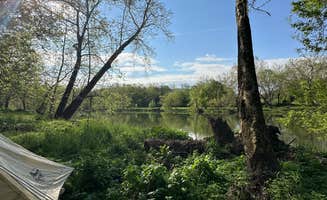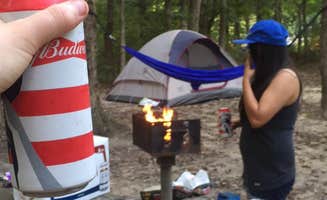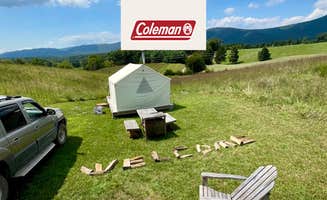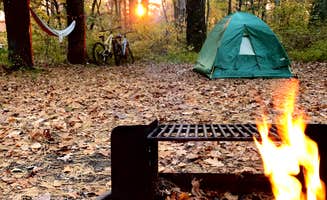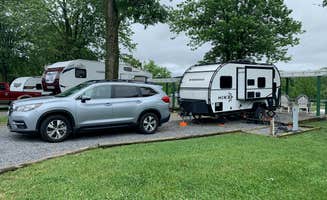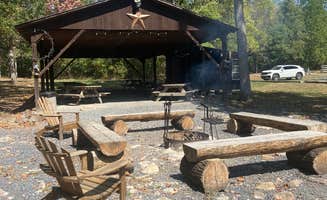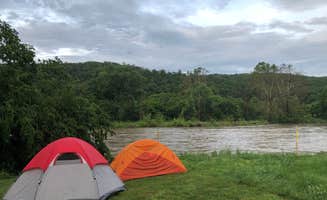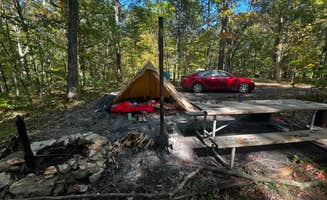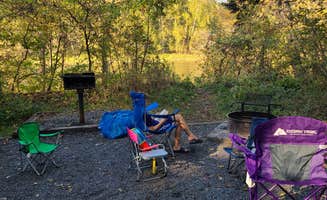Camping options near Rileyville, Virginia range from rustic to full-service sites nestled between the Blue Ridge Mountains and Shenandoah River. Elevations vary from about 700 feet in riverside camping areas to over 3,000 feet at mountain campgrounds, creating significant temperature differences even in summer months. Many riverside campsites flood during spring runoff, making late summer and fall the most reliable seasons for waterfront camping.
What to do
Fishing at creekside spots: The Shenandoah River and its tributaries offer excellent fishing opportunities. At Creekside Campground, "Ducks are there and you hear the water which is very soothing to us. A short drive away is the usual assortment of convenience stores, restaurants and grocery stores."
Mountain biking trails: Several campgrounds connect to trail systems. "Park offers very doable hiking and mountain biking options for beginners. Campground access to the Shenandoah River," notes one camper about Shenandoah River State Park.
Tubing and kayaking: Many campsites serve as launch points for water activities. At Low Water Bridge Campground, "Love the fact that they have an outfitter to shuttle you up the river. We got a site right on the river bank so we just hopped out and were at our site!"
Stargazing on clear nights: Higher elevation campgrounds provide excellent night sky viewing. "Very happy for the nearby heated restrooms with hot running water," reports a winter camper at Big Meadows who experienced temperatures dropping to 14°F at 3,000+ feet elevation.
What campers like
Private riverfront access: Many campers seek sites directly on the water. "The primitive spots are right next to the river. The spots are a short walk from the parking area and the campground provides wagons to transport your stuff. Great fishing and swimming right at your camping spot," explains a visitor at Shenandoah River State Park.
Wildlife encounters: Deer sightings are common throughout the area. "Though this campground is HUGE, the sites are not piled on top of each other. Our site, B112, was surrounded by shrubs under the canopy of trees which provided tons of privacy. You will definitely see deer in the campground as they walk through and browse the understory."
Winter camping options: Some campgrounds remain open year-round. At Big Meadows Campground, "We camped here the last night of the season (Nov30) and shared the campground with a mix of tent campers, car/van campers, and a few larger units. The bathrooms were plentiful, heated, hot running water."
Remote backcountry solitude: For those seeking true wilderness. "There are so many trails to hike throughout the park and with a backcountry permit, you can find countless campsites. I stayed in the area of overall run falls. Make sure to hang your food. There are plenty of black bears in the area."
What you should know
Bear safety protocols: Bears are active throughout the region. At Mathews Arm Campground, "Sites come with picnic tables and fire grates. There are no bear boxes at this campground, but there are indeed bears, so keep all food in your car."
Variable cell service: Coverage is inconsistent across the region. "No cell service. We went to the visitor center and connected to the WiFi if we needed to do something online," reports a camper at Big Meadows.
Weather fluctuations: Temperature swings can be significant, especially at higher elevations. "We needed every layer we brought, including winter hats, puffy jackets, and gloves. During the 6 days we were in the backcountry, we experienced everything from warm summer-like weather to chilly winter winds."
Creek crossings on trails: Spring runoff creates challenging conditions. "The creeks (runs) and springs are really flowing this time of year, with some nearly thigh deep. We didn't see a single bridge, though there were a few creeks that had downed trees or make-shift rock crossings."
Tips for camping with families
Kid-friendly attractions: Several campgrounds offer dedicated children's activities. At Yogi Bear's Jellystone Park, "The kids loved running off in the open field and playing on the zip line. We loved that we could see them from our site. The birthday boy also loved the outdoor laser tag!"
Educational programs: Ranger-led activities engage young campers. "Nice amphitheater with interesting ranger programs. Busy traffic in park but nice trails are accessible from campground. Visitor Center, gas station, food walking distance from campground."
Swimming areas: River access points provide natural swimming holes. At Gooney Creek Campground, one visitor shared, "We had a great time at Gooney Creek. The Mountain View is gorgeous. We even saw a doe and fawn right in our campsite!"
Campground layouts: Some sites work better for families than others. "Most, if not all, sites have a fire ring and picnic table. Sites were first come first serve. Free to camp. We camped so we could spend two days on the OHV Trails with the Jeep. Had an incredible time."
Tips from RVers
Site levelness varies significantly: Some campgrounds have more suitable RV spots than others. At Luray KOA, "We stayed in a level back-in site(#28) with picnic table on a concrete patio, Adirondack chairs under a pergola on a second concrete patio, clean gravel surface, and fire pit. The site was big enough for our motor home and Jeep."
Mountain access roads: The terrain presents challenges for larger vehicles. "The drive in requires about 25-miles through the roller coaster of steep grade(7+%) hills. There's no way around that, you're in the mountains. Just be aware and be prepared."
Seasonal utility availability: Water systems may be winterized in colder months. "Water and electrical available at all the spots even though it was winter. Bathrooms and showers were nearby and clean. No cell service but the Visitor's Center has WiFi available."
Limited dump stations: Plan ahead for waste disposal. "RV sites are spaced out and have wooden fences on the sides. 30 amp service at the site. You can fill your water tanks as you enter the campground."


